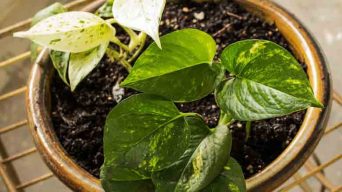Pothos plants (epipremnum aureum) are a type of evergreen vine commonly grown as houseplants.
They are easy to care for and can tolerate a wide range of growing conditions.
However, one of the most common problems with pothos plants is overwatering.
Here’s what you need to know about overwatered pothos plants, including how to identify, treat and prevent it.
What Are the Risks of Overwatering a Pothos Plant
Overwatering is one of the most common problems with pothos plants.
While they are tolerant of a wide range of growing conditions, pothos plants can quickly become waterlogged if they are overwatered.
This can lead to several problems, including:
Root Rot
The most common problem associated with overwatering is root rot.
Root rot is a condition where the plant’s roots start to decay.
This can happen when the roots are constantly wet, which prevents them from getting the oxygen they need to stay healthy.
As the roots decay, they will become mushy and fall apart.
This can decrease the plant’s ability to absorb water and nutrients, which can eventually kill the plant.
Fungal Growth
Another common problem associated with overwatering is fungal growth.
Fungi love damp, dark conditions, and overwatered pothos plants provide the perfect environment for them to thrive.
Common signs of fungal growth include yellow or brown patches on the leaves, mushy stems, and a white fuzzy substance on indoor plants.
A common fungus that affects overwatered pothos plants is powdery mildew.
Powdery mildew is a white powdery substance that forms on the leaves and stems of the plant.
It has the potential to induce yellowing or browning of pothos leaves, ultimately leading to their demise.
Bacterial Problems
Bacteria can also be a problem in overwatered pothos plants.
Bacteria thrive in wet conditions and can cause several problems, including leaf spot and stem rot.
Leaf spot is a condition where yellow or black spots form on the pothos leaves.
This can be a sign of bacterial leaf spot, a type of bacteria that affects pothos plants.
Stem rot is another common bacterial problem that can affect overwatered pothos plants.
Stem rot is a condition where the plant’s stem starts to decay.
This can happen when the stem is constantly wet, allowing bacteria to grow and spread.
As the stem rots, it will become mushy and fall apart.
This can eventually kill the plant.
Insect Problems
Overwatered pothos plants can also attract several insects, including aphids, whiteflies, and mealybugs.
These insects suck the sap from the plant, weakening it and making it more susceptible to disease.
Aphids are small, green insects that congregate on the stems and leaves of the plant.
Whiteflies are small, white insects that fly around the plant and lay their eggs on the leaves.
Mealybugs are small, white, fuzzy insects that feed on the plant sap.
They can cause leaf yellowing, stunted growth, and a sticky substance on the leaves (honeydew).
Poor Growth
Overwatered pothos plants often have poor growth.
This can be due to some factors, including root rot, fungal growth, and insect infestation.
Root rot can prevent the plant from getting the water and nutrients it needs, leading to stunted growth.
Fungal growth can also inhibit the plant’s ability to absorb water and nutrients, which can cause stunted growth.
Insect infestation can also weaken the overwatered plant and cause stunted growth.
How Does Overwatering a Pothos Occur
There are several ways that overwatering can occur.
Some of the most common include:
Watering Too Often
One of the most common reasons for overwatering is watering your pothos plant too often.
Pothos plants need to be watered about once a week or when the soil is dry to the touch.
If you water your plant more than this, it can become waterlogged.
Not Allowing the Soil To Dry Out Between Watering
Another common mistake people make is not allowing the soil to dry out between watering.
Pothos plants need to have well-draining soil so that the roots don’t become waterlogged.
If you water your plant before the soil has a chance to dry out, pothos plants can start to develop root rot.
Only water your plant when the soil is dry to the touch.
Using the Wrong Type of Soil
Using the wrong type of soil can also lead to overwatering.
Pothos plants need well-draining potting soil so that their roots don’t become waterlogged.
If you use a soil that doesn’t drain well, it can hold too much water and cause the plant to become overwatered.
When growing pothos plants, using well-draining potting soil, such as a potting mix or cactus mix, is essential.
Not Using a Drainage Hole
If your pot doesn’t have a drainage hole, it can lead to overwatering.
When watering your plant, the water will fill up the pot and start to pool at the bottom.
This can cause the roots to become waterlogged, leading to root rot.
When growing pothos plants, using a pot with a drainage hole is essential.
Place a layer of rocks or gravel at the bottom of the pot to help with drainage.
Watering With Too Much Water
Watering your plant with too much water can also lead to overwatering.
Pothos plants need about 1 inch (2.5 cm) of water per week.
If you water your plant with more than this, the excess water will start to pool at the bottom of the pot.
This can lead to the roots becoming waterlogged and developing root rot.
To water your plant correctly, stick your finger into the potting soil.
If it’s dry to the touch, it’s time to water your plant.
If it’s still wet, wait a few days and check again.
Using Hard Water
Hard water can also lead to overwatering.
Hard water is water that has high mineral content.
These minerals can build up in the soil and prevent the plant from getting the water it needs.
To avoid this, water your plant with distilled or filtered water.
Fertilizing Too Much
Fertilizing your plant too much can also lead to overwatering.
Pothos plants need to be fertilized about once a month during the growing season.
If you fertilize your plant more than this, it can start to burn the roots.
When the roots are burned, they can’t absorb water and nutrients properly.
This can lead to the plant becoming overwatered.
Only fertilize your plant when actively growing, and use a well-balanced fertilizer.
Dilute the fertilizer to half the recommended strength to avoid burning the roots.
How To Identify If Your Pothos Is Overwatered
Pothos plants are very hardy, so they can tolerate a bit of overwatering.
However, if your plant is overwatered for an extended period, it can show signs of stress.
Signs of an Overwatered Pothos Plant
There are a few signs that you can look for to determine if your pothos plant is overwatered.
Some of the most common signs of overwatering include:
Yellow or Drooping Leaves
One of the most common signs of overwatering is drooping or yellow leaves.
This happens because the roots cannot absorb water and nutrients properly.
The pothos leaves will droop down and start to turn yellow.
If you see this happening, it’s essential to check the soil.
If the soil is soggy or wet, it’s a sign that your plant is overwatered.
Brown Spots on the Leaves
Another common sign of overwatering is brown spots on the leaves.
This is caused by a fungal disease called leaf spot.
Leaf spot is a common problem in overwatered plants.
The spots will start small, but they can quickly spread and cover the entire leaf.
If you see brown spots on your pothos leaves, it’s good to check the roots.
If the roots are mushy, it’s a sure sign that the plant is overwatered.
Soil that is Soggy and Muddy
If you are watering your plant and the soil is still soggy and muddy, it’s a sign of overwatering.
When the roots are waterlogged, they can’t absorb water properly.
This can cause the soil to stay soggy and muddy.
If you see this happening, it’s important to stop watering your plant and check the roots.
If the roots are mushy or rotting, it’s a sign that the plant is overwatered.
Mold on the Soil
Mold is another common problem in overwatered plants. It will often form on the surface of the soil.
It can appear as white, fuzzy patches, or it can be black and slimy.
Mold is not only unsightly, but it can also be harmful to your plant.
If you see mold on the soil, it’s a sure sign that your plant is getting too much water.
Leaves that are Falling Off
If the leaves of your pothos plant are falling off, it’s a sign that the plant is stressed.
This can be caused by overwatering, but it can also be caused by other problems, such as pests or diseases.
If you see the leaves of your pothos plant falling off, check the roots to see if they’re healthy.
If the roots are rotting, it’s a sign that the plant is overwatered.
How To Save an Overwatered Pothos Plant
When it comes to overwatered plants, the best course of action is to catch the problem early.
If you notice any signs of overwatering, it’s crucial to take action immediately.
The longer you wait, the more damage will be done to your plant.
Here are some tips for saving an overwatered pothos plant:
1. Stop Watering Your Plant
If you notice any signs of overwatering, the first thing you should do is stop watering your plant.
It’s essential to give the plant a chance to dry out.
If you continue to water your plant, it will only worsen the problem.
Let the soil dry out thoroughly before you water your plant again.
2. Check the Roots
Once you’ve stopped watering your plant, it’s time to check the roots.
Gently remove the plant from its pot and examine the roots.
If they’re healthy, they’ll be white or cream-colored.
If they’re overwatered, they’ll be brown and mushy.
But if your plant’s roots are overwatered, you can do a few things to save it.
First, trim off any dead or damaged roots. Then, replant the pothos in a fresh, well-draining potting mix.
Be sure to water pothos plants only when the soil is dry to the touch.
3. Repot Your Plant
If your plant is overwatered, it’s a good idea to repot it.
This will give the roots a chance to dry out and recover.
Choose a slightly larger pot than the one your plant is currently in.
Fill it with a well-draining potting mix, such as a cactus mix or a mix that contains perlite or sand.
Water your plant only when the soil is dry to the touch.
4. Prune Your Plant
If your plant is severely overwatered, you may need to prune it.
Prune off any yellow, brown, or dead leaves.
This helps the plant focus its energy on new growth.
It also helps to reduce the chances of fungal diseases.
You may need to cut the plant back quite a bit, but don’t worry, it will quickly recover.
5. Place Your Plant in a Bright, Sunny Spot
If your plant is overwatered, it’s important to give it bright, indirect sunlight.
This will help the plant dry out and recover.
Avoid placing your plant in direct sunlight, as this can scorch the leaves.
Pothos plants are very tolerant of low light, so don’t worry if you can’t find a spot that gets full sun.
A bright, sunny windowsill will do the trick.
6. Be Patient
Once you’ve taken steps to save your plant, it’s important to be patient.
It will take time for the plant to recover from overwatering.
But with a bit of care and attention, your plant will be back to its old self in no time.
How To Prevent Overwatering a Pothos Plant
Pothos plants are very tolerant of neglect, but they’re not immune to overwatering.
That’s why it’s essential to be careful not to overwater your plant.
Here are some tips for preventing overwatering a pothos plant:
1. Water Your Plant When the Soil is Dry
One of the easiest ways to prevent overwatering is to water your plant only when the soil is dry.
Stick your finger in the soil to see if it’s dry before you water your plant.
If it’s damp, wait a few more days before watering.
2. Use a Well-Draining Potting Mix
When potting or repotting your pothos plant, use a well-draining potting mix.
A mix that contains perlite or sand is ideal.
Avoid using a potting mix that contains peat moss, as it holds too much water.
3. Use the Right Size Pot
When potting your pothos plant, be sure to use a pot that is only slightly larger than the one it’s currently in.
A pot that is too large will hold too much water and can lead to overwatering.
4. Use a Pot with Drainage Holes
When potting your pothos plant, be sure to use a pot with drainage holes.
This will help excess water drain away from the roots and prevent overwatering.
5. Check the Drainage Hole
Before watering your plant, check the drainage hole to make sure it’s not blocked.
If it is, the water will have nowhere to go and will quickly drown the roots.
5. Don’t Let Your Plant Sit in Water
After watering your pothos plant, empty the drip tray or saucer.
Don’t let your plant sit in water for more than a few hours, as this can lead to overwatering.
6. Don’t Water Too Often
Avoid watering your pothos plant too often.
Pothos plants need to be watered about once a week, or when the soil is dry to the touch.
Watering more often than that can lead to overwatering.
Final Thoughts
Overwatering is a problem that can easily be fixed with the right knowledge.
If you think your pothos plant is overwatered, follow the tips in this article to help it recover.
Most importantly, water your plant only when the soil is dry to the touch, and use a well-draining potting mix.
With a bit of care and attention, your plant will be back to its old self in no time.







